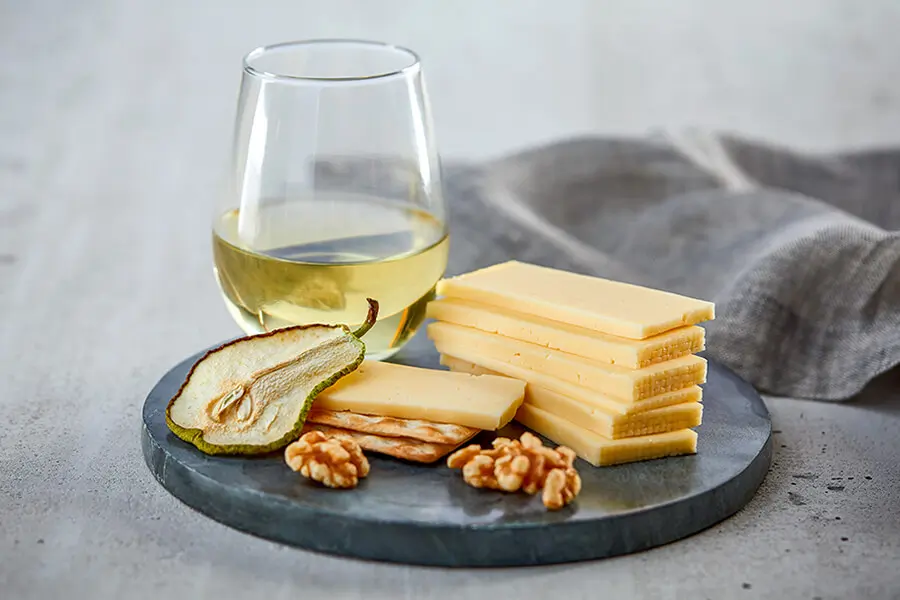Introduction to White Wine
Welcome to the delightful and diverse world of white wine! This guide is crafted to help beginners and enthusiasts alike navigate the vast and varied landscape of white wines. Known for their refreshing qualities, white wines offer a broad palette of flavors and aromas, making them a versatile choice for any occasion, from casual gatherings to elegant dinners.
Popular Types of White Wine
Let’s explore the different types of white wine, each with its unique charm:
- Chardonnay: A global favorite, Chardonnay can be crisp and unoaked or rich and buttery. It’s a versatile wine that pairs beautifully with dishes like creamy pasta and roasted chicken.
- Sauvignon Blanc: Celebrated for its vibrant acidity and fresh flavors, Sauvignon Blanc often features notes of citrus and green apple. It’s a perfect match for seafood and light salads.
- Riesling: Riesling ranges from dry to sweet, known for its floral aromas and flavors of stone fruits. It’s an excellent companion for spicy dishes and Asian cuisine.
- Pinot Grigio/Gris: Light and crisp, Pinot Grigio is a refreshing choice on a warm day, pairing well with light appetizers and seafood.
- Gewürztraminer: With its aromatic profile and a hint of spice, Gewürztraminer is a unique and flavorful option, great with aromatic cheeses and spicy dishes.
White Wine Tasting Tips
Enhance your tasting experience with these tips:
The Five S’s:
See, swirl, sniff, sip, savor – the steps to fully appreciate the complexity of white wine (Click here to learn more)
Best Wine Glass for White Wines:
- Shape: White wine glasses typically have a narrower bowl compared to red wine glasses. This design helps to maintain cooler temperatures and preserves the floral aromas.
- Material: Crystal or thin glass is often preferred as it allows you to get a better sense of the wine’s aroma and doesn’t interfere with the taste.
- Size: A medium-sized glass is ideal. It should be large enough to swirl the wine a bit, which helps to release its aromas.
- Specific Varieties:
- For lighter, crisper whites like Sauvignon Blanc or Pinot Grigio, a taller, more upright glass helps to direct the wine to the front of the mouth.
- For fuller-bodied whites like Chardonnay, a slightly larger glass that directs the wine to the back and sides of the mouth is preferable.
Ideal Serving Temperature for White Wines:
- Lighter, Dry Whites (e.g., Sauvignon Blanc, Pinot Grigio): Serve these between 45°F to 50°F (7°C to 10°C). This temperature range highlights their crispness and acidity.
- Fuller-bodied Whites (e.g., Chardonnay, White Burgundy): Serve slightly warmer, between 50°F to 60°F (10°C to 15°C). A bit of warmth can enhance the complexity and richness of these wines.
- Sparkling Whites: Serve these coldest, between 40°F to 45°F (4°C to 7°C), to maintain their refreshing effervescence.
Tips for Enjoyment:
-
- Chilling: Place the white wine in the refrigerator for a couple of hours before serving. Avoid freezing.
- Decanting: Not typically necessary for most white wines, but older or more complex whites might benefit from a bit of aeration.
- Refrigeration Post-Opening: If you don’t finish the bottle, re-cork it and keep it in the fridge to maintain freshness.
White Wine Terminology
1. Varietal
This term refers to the type of grape used in the production of the wine. Common white wine varietals include Chardonnay, Sauvignon Blanc, Riesling, and Pinot Grigio. Each varietal has its unique flavor profile and characteristics.
2. Body
The body of a wine refers to its weight or fullness on the palate. White wines can be light-bodied (like Pinot Grigio), medium-bodied (like Sauvignon Blanc), or full-bodied (like many oaked Chardonnays).
3. Bouquet/Aroma
These terms refer to the smells and fragrances of wine. Aromas are generally derived from the grape and fermentation process, while the bouquet develops as the wine ages. Descriptors can range from fruity and floral to nutty and spicy.
4. Dry, Off-Dry, Sweet
These terms describe the level of residual sugar in the wine. Dry white wines have little to no residual sugar, off-dry wines have a slight sweetness, and sweet wines, like some Rieslings, have high levels of residual sugar.
5. Acidity
Acidity in wine is what gives it its tartness and crispness. White wines are often celebrated for their refreshing acidity, which can range from low to high.
6. Terroir
This French term refers to the environment in which the grapes are grown, including factors like soil, climate, and topography. Terroir can greatly influence the taste and characteristics of a wine.
7. Oaky
This term is used when a wine has been fermented or aged in oak barrels. It imparts flavors such as vanilla, butter, and spice. Not all white wines are oaked; many are fermented in stainless steel tanks to preserve their fresh, fruity qualities.
8. Vintage
Vintage refers to the year the grapes were harvested. It can be an indicator of quality and flavor, as weather conditions vary each year and affect the final product.
9. Sommelier
A sommelier is a trained and knowledgeable wine professional, typically working in fine restaurants, who specializes in all aspects of wine service and pairing.
10. Finish
The finish of a wine is the impression it leaves after tasting. It can be short or long and is a key component in assessing a wine’s quality.
11. Minerality
This term is often used to describe a taste quality in wine that is reminiscent of minerals. Some people associate it with the taste of wet stone or a saline quality.
12. Lees
Lees refers to the sediment of yeast particles in wine, which can impart additional flavors and textures, especially in richer, more complex white wines.
13. Legs/Tears
When you swirl wine in a glass, the droplets that form and slide down are called legs or tears. They can give clues about the wine’s alcohol and sugar content.
Understanding these terms can enhance the wine-tasting experience and help in selecting the right white wine for different occasions and food pairings. Whether you’re a casual enthusiast or a seasoned connoisseur, familiarizing yourself with this lingo can deepen your appreciation for the diverse world of white wines.
Conclusion and Further Exploration
As you conclude this guide, remember that the world of white wine is vast and full of surprises. Keep exploring, tasting, and learning. Your journey into the nuanced and elegant realm of white wines is just beginning.
Click here to discover our white wine collection at Vasanti Estate Winery


